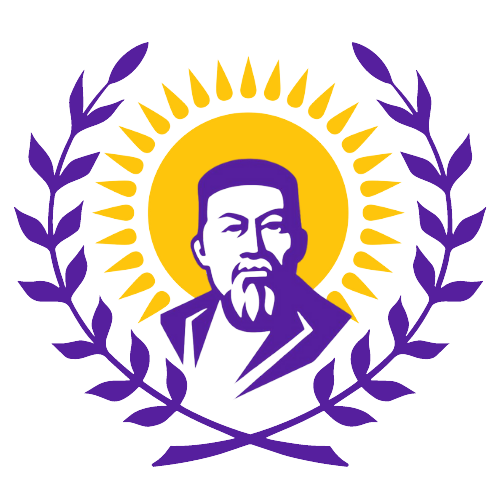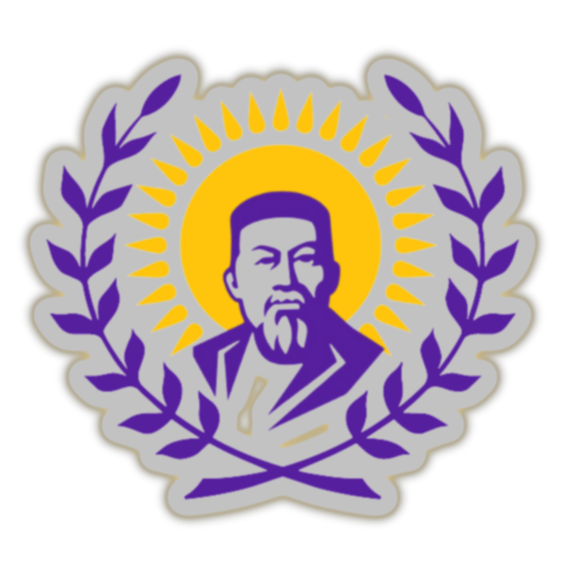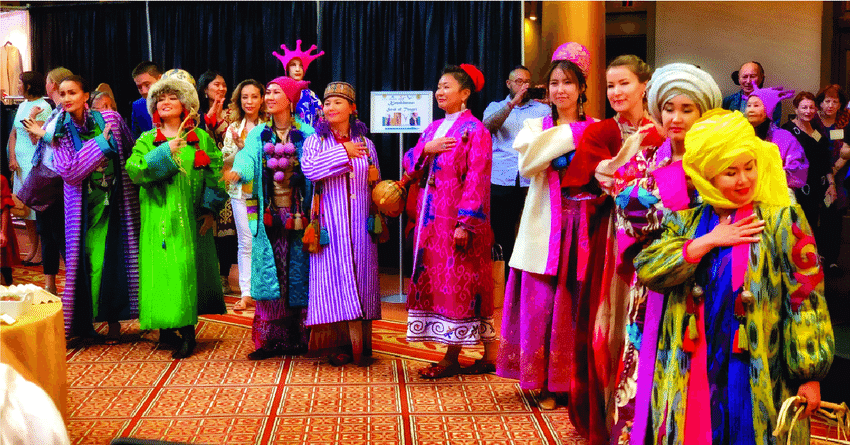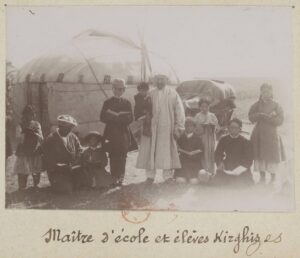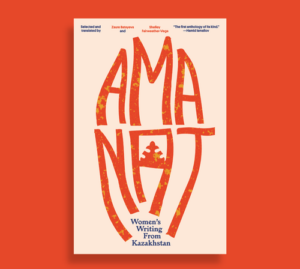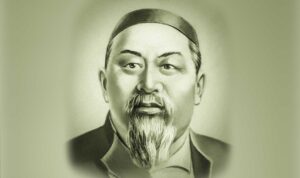When asked by the Embassy of Kazakhstan to contribute an article about the Smithsonian’s partnerships with Kazakhstan (and especially our recent exhibition and publication with the Kasteyev Museum in Almaty), for this recently established online publication series for the Abai Center, I quickly agreed. Our Smithsonian research team has long been active and interested in Kazakhstan, so we are among the many Washington-area beneficiaries of this exciting new initiative at The George Washington University’s Institute for European, Russian, and Eurasian Studies (IERES), the Abai Center.
The Smithsonian’s Asian Cultural History Program (ACHP), within its department of Anthropology (National Museum of Natural History), has a long history of partnerships that have grown out of an original, long-ago-expired formal agreement between the Museum of Natural History (Smithsonian) and the Kasteyev State Museum of Art in Almaty, Kazakhstan. That agreement was set up in 2006, expiring two years later, within the framework of a temporary program within the American Association of Museums (AAM), funded by the Department of State, known as the “International Partnership Among Museums” or IPAM program. “IPAM” was essentially a small grant program offering seed funds for two museums, one American and one overseas, to develop some shared goals then carry out exchange visits between them, during which they could also explore potential collaborations.1 Though that official program ended long ago, its good effects continue to resonate and to result in joint activities up to the present. Here I begin by describing the most recent joint activity, then return to origins of the partnership in 2006 and review some subsequent developments.2
Kazakhstan’s Crafts and the Smithsonian’s Annual “Craft2Wear” Show in 2019
Most recently, the Smithsonian and the Kasteyev Museum co-organized an international symposium on “Kazakhstan’s Crafts and Creative Economy,” held in October 2019 at Washington’s National Building Museum during the annual Smithsonian “Craft2Wear Show.” This symposium was an important landmark in cultural and academic relations between Kazakhstan and the U.S.A. For many years prior to this, our two countries had exchanged international exhibitions and training programs. Yet the idea of jointly conducting an international scholarly symposium about the arts and culture of Kazakhstan in the U.S.A. was, in 2019, still quite an innovative form of dialogue. The Kasteyev State Museum of Arts, working with the Smithsonian’s Asian Cultural History Program, thought that an ideal venue for our joint symposium about Kazakhstan’s craft traditions would be a major annual event held in Washington each Fall — the Smithsonian “Craft2Wear Show,” which brings together crafters, makers and marketers of craft, and craft specialists from around North America for an annual juried exhibition held in Washington’s National Building Museum. The internationally known event is organized each year by an active and experienced group of volunteers, the Smithsonian Women’s Committee.

Figure 1. Artisans from Kazakhstan, who showed their “wearable craft” art at the Smithsonian Craft2Wear Show, Oct. 3-5. From left: Serik Rysbekov, Ulbossyn Daulenova, Gulmira Terlikbayeva (Gulmira Ualihan), Aizhan Bekkulova (4th from left, head of the Union of Artisans), Talshyn Koken (Talshyn Kokenova), with (6th from left) their and our Washington-based friend Dr. Tokjan Balderston, then (7th from left) Serikkaliy Kokenov (Сериккали Кокенов), Ikramzhan Rafikov (Ikram Rafikov), Dulat Ashimov, Serzhan Bashirov, and (squatting at center, front) Iliya Kazakov. Participating artist (jeweler) Almas Mustafayev (Almas Serikuly) was absent from this photo.
The Craft2Wear Show’s many visitors formed a large potential audience for teaching about crafts of Kazakhstan, though they would surely also want to see some examples first-hand, in addition to the images we could offer within a symposium about those crafts. We were thus very fortunate that Aizhan Bekkulova, Head of the Union of Artisans of Kazakhstan, visited Washington in early 2019 and toured the National Building Museum along with representatives of the Smithsonian Women’s Committee and the Asian Cultural History Program. Together we envisioned a unique arrangement for October 2019, in which craft artisans from Kazakhstan would display their crafts from Kazakhstan in the auditorium area (see Figure 1), near where the scholarly symposium on Kazakhstan’s Crafts and Creative Economy would take place. The resulting exhibition presented a wide range of craft types, beautifully displayed during the four days of the Show, drawing considerable attention from visitors as well as from the American craft artists, marketers, and other craft experts who attended. We received support for this combined scholarly symposium and craft display from the Embassy of the Republic of Kazakhstan and from Chevron – which has been a longtime friend of the Smithsonian’s partnerships with Kazakhstan’s cultural institutions. For this the organizers expressed thanks to Chevron, to Ambassador and Mrs. Erzhan Kazyhanov, and to the Embassy staff including AbaI Besken and Zhandos Imanaliyev. The organizers also thanked the Smithsonian Institution Women’s Committee (organizers of the Craft2Wear Show), and its Coordinator, Heidi Austreng.
The October 2019 scholarly symposium was co-organized by Dr. Gulmira Shalabayeva (director, Kasteyev State Museum of Arts) and Dr. Paul Michael Taylor (Smithsonian Institution). They went on to become co-editors of the resulting book. Less than a year later, in September 2020, the full color-illustrated book of proceedings from that international scholarly symposium – having the same title Kazakhstan’s Crafts and Creative Economy – was launched in Almaty as part of the 75^th^ anniversary activities of the Kasteyev Museum (see Figure 2). Its chapters brought together researchers from both institutions, the Smithsonian and the Kasteyev State Museum of Arts. The book is now fully available online here.

Figure 2. Kazakhstan’s Crafts and Creative Economy: Proceedings of an International Symposium (Taylor and Shalabayeva, 2020).
Our Washington symposium was designed to bring together researchers from both institutions, with five speakers from each museum presenting, at the symposium itself, preliminary versions of the papers included within that volume. As the host institution, the Smithsonian’s role was to provide the venue for the topical papers from Kazakhstan, and also introduce the Kazakhstani guests to the Smithsonian. Thus, we decided to structure the seminar such that the nature of the papers presented by scholars of the two institutions was quite different, as reflected in the resulting papers. Each of the five speakers from Kazakhstan at the October 2019 symposium discussed an important aspect of the topic, Kazakhstan’s crafts and creative economy. Then, due to the limited amount of time available, and the great interest on the part of all the audience in the crafts of Kazakhstan, each Smithsonian speaker served primarily as “respondent” or “discussant” of the Kasteyev speaker’s paper. Thus, Smithsonian speakers were given only a few minutes to discuss and respond at the symposium itself, and were also asked to very briefly describe (for comparative purposes) the approach to craft studies that the speaker was applying at the Smithsonian, identifying common areas of interest and potential future areas of research. This brief response at the symposium was only later expanded by each Smithsonian speaker into a full paper in the resulting book.
The five symposium speakers from the Kasteyev State Museum of Arts were: Prof. Gulmira Shalabayeva, Director; Yekaterina Reznikova; Clara Isabaeva; Gulaim Zhumabekova; and Oxana Tanskaya – with each paper surveying important aspects of the craft traditions of Kazakhstan. The Smithsonian speakers (respondents) and contributors were Paul Michael Taylor, Jasper Waugh-Quasebarth, Inigo Acosta, Robert Pontsioen, and Jared M. Koller – each summarizing a particular approach to craft studies outside of Kazakhstan (in the USA, Thailand, Japan, or elsewhere), as used in the work of these speakers, considered relevant to the work of the Kazakhstani participants and presented as part of their introduction to the Smithsonian and its activities (see Figure 3). In addition to papers from these ten speakers , the editors later solicited relevant papers for our topic from six additional authors, including Aizhan Bekkulova, the above-mentioned head of the Union of Artisans of Kazakhstan. The other authors contributing important papers on Kazakhstan’s craft traditions are all from the staff of the Kasteyev Museum: Nataliya Bazhenova, Amir Jadaibaev, Svetlana Kobzhanova, Galina Syrlybayeva, Nurzhamal Nurfeizova. The symposium was later made available online here.

Figure 3. Scholars gathered for the Kazakhstan’s Crafts and Creative Economy Symposium at the Smithsonian Craft2Wear Show. Left to right: [from Smithsonian:] Adam Grode [from Kasteyev:] Katerina Reznikova, Oxana Tanskaya, Gulaim Zhumabekova, Clara Isabaeva, and (Director) Gulmira Shalabayeva); [then from SI:] Paul Michael Taylor, Jasper Waugh-Quasebarth, Robert Pontsioen, Supamas Snitwongse, Jared Koller, and Evan Wainright.
Participants and visitors to the annual Craft2Wear show could thus not only attend the symposium on Kazakhstan’s crafts but also see the accompanying exhibit and craft-making demonstrations. Members of the Union of Artisans of Kazakhstan who displayed their artworks in Washington included the head of that Union, felt-maker and felt artist Aizhan Bekkulova, as well as Serik Rysbekov, Ulbossyn Daulenova, Gulmira Terlikbayeva (Gulmira Ualihan), Talshyn Kokenova (Talshyn Koken), Serikkaliy Kokenov, Ikramzhan (Ikram) Rafikov, Dulat Ashimov, Serzhan Bashirov, Iliya Kazakov, and Almas Mustafayev (Almas Serikuly)3.
The theme of the event (and of our symposium and book), Kazakhstan’s Crafts and Creative Economy, referred to a very important range of phenomena, including art historical studies of individual craft forms, examinations of balancing preservation of traditional crafts with production of creative transformations of those crafts within today’s global economy, surveying the importance of crafts as icons of local and national identity, and even the reflexive realization that this conference and exhibition constituted examples of how crafts play a role in cultural diplomacy between nations. The edited book’s authors attempt to comprehend and preserve traditional values that historically identify a nation or ethnic group; yet on the other hand they seek to describe the modifications of those same craft traditions in light of a global community with varying outlooks and preferences. These intersections and counterpoints made this symposium and its topic an important forum for discussion among scholars. The event and resulting book are tangible results of our serious and continuing cooperative work and a testimony to this important international museum collaboration, representing the most recent example of cooperation of the kind begun in 2006, which has continued from then to the present day.
IPAM: International Partnership Among Museums (2006)
As mentioned above, the long series of cooperative activities with Kazakhstan’s museums had first been formalized by our joint, successful application for an IPAM grant in 2006, whose then-expressed aims were modest but potentially long-lasting:
- To develop the capacity, within our respective institutions, for sharing our collections-based research using digital technologies.
- To explore the collaborative construction of virtual exhibits, and other means of disseminating information, about the ethnography and material culture of Kazakhstan. The development of such web-based exhibits and educational resource materials would assist educators and students in understanding the ethnography, traditions, and material heritage of Kazakhstan. Alongside other specialized scholarly publications, these products can constitute an important means by which we bring research (and new perspectives) in this relatively little-known field to the public.
Our successful grant application, seeking only the funds for a single exchange visit of one staff member from each museum to the other’s museum, mentioned that each museum had a prior exchange visit: myself as an anthropologist and curator participating in a State Department-funded Program on Museum Management for the Post Soviet Republics which included a 1999 visit and seminar in Almaty, and a 2003 “IVLP” (International Visiting Leaders Program) State Department-sponsored visit by a Kasteyev staff member among visitors to the Smithsonian. The two IPAM-funded visits took place in 2007 and 2008, growing to include many seminars and workshops on the then-new fields of museum digitization, construction of multi-media databases, and web-based interface with the public for information about museum collections. Two Smithsonian researchers (including the author of this paper) and one network administrator – I.T. specialist, traveled in October 2007 for seminars, workshops, and museum or historic site visits in Almaty, Turkestan, Otrar, Shymkent, Astana, Karaganda, and Kokshetau.
This was just one of many regular subsequent “seminar tours” in Kazakhstan between 2007 and 2018; we long ago stopped thinking of the dialogs taking place at our seminars and workshops as one-sided “lectures” but rather as interactions with our Kazakhstani counterparts, from which we often derive good ideas for follow-up joint activities.
Museum Partnerships and Workshops for the Development of “Flagship Projects”
After our series of workshops in 2007, regular visits brought workshops to Pavlodar, Semey (Semipalatinsk), Atyrau, Oral (Uralsk), and other locations, including such unforgettable historic sites of Kazakhstan’s recent history such as Alzhir as well as the carefully reconstructed and preserved site of Chokan Valikhanov’s childhood home in Syrembet. Each of these places has unique collections and local circumstances that require specific considerations within the sphere of cultural preservation and representation of history in museums and monuments.
The seminars and workshops described above, combined with exchange of staff (Kazakhstani museum staff visiting Washington, and Smithsonian museum staff visiting museums of Kazakhstan) have been inspirational in developing specific joint projects. In fact, each of the seminars ends with a “roundtable” discussion among the program participants (Smithsonian representatives as well as the participants from museums of Kazakhstan), as a kind of brainstorming session to discuss ideas for next steps (Taylor 2009). From these productive exchanges several ideas for presentations of Kazakhstan’s cultural heritage in the United States were developed, including “heritage” projects comparable to those developed for particular community groups (see e.g. Taylor 2004), which have led to lectures, performances, and short-term exhibitions in Washington.
One of our follow-up seminar-workshops (after the IPAM-funded exchanges of 2007-2008) was again held in Almaty (led by myself with Smithsonian researcher Jared Koller) in 2009. That 2009 “workshop” held at Almaty’s Kasteyev Museum led directly to a very successful follow-up project, our 2010 publication of a website about the scientific expeditions of Chokan Valikhanov (see Figure 4). This directly resulted from the fact that, in our 2009 Almaty workshop, we examined in detail the way I had previously gone about writing and publishing a major online research resource about a different scientific expedition – By Aeroplane to Pygmyland (Taylor 2006), an online publication of the collections, notes, and findings of a 1926 expedition to Western New Guinea (at that time, Dutch New Guinea). At our roundtable discussion following the presentation of that web-based research publication, someone suggested preparing a comparable website about the expeditions of the great Kazakh geographer and ethnographer, Chokan Valikhanov. That interesting idea was discussed but set aside for the future – and the future arrived less than a year later when the opportunity arose to carry out that project.
Presenting the Legacy of Chokan Valikhanov (1835-1865), with Kazakhstan’s Museums
Though at this writing (2020) a recent removal of research websites from Smithsonian sites has made our Valikhanov website temporarily inaccessible (accept in archived form)4, the formation and launch of the Valikhanov website provides a very good example of a museum partnership.
This became one of the most publicly visible “flagship project” to result from these museum seminar-workshops. Because there was considerable interest among Kazakhstan’s museum scholars in the application of information technology to museums, we examined this and other online scholarly works in detail, as various potential models for development with Kazakh subject-matter, which would allow for interpretive essays, as well as large amounts of illustrative data, all in a fully annotated and interconnected multimedia format which would allow for comparison among multiple sources.
Consequently, we can say that this idea of creating an online publication and research resource about the “expeditions” of the great Kazakh ethnographer and geographer Chokan Valikhanov grew out of a 2009 curatorial capacity-building workshop. Yet in this particular case, the opportunity to actually produce such an important research resource (rather than just talk about it at a seminar or workshop) materialized later that year when, thanks to the support of the Smithsonian’s Office of Policy and Analysis working with the Embassy of Kazakhstan and with the financial support of Chevron, we were given an unprecedented opportunity to develop the project and hold a very successful launch event in Washington during the visit of the President of Kazakhstan to that city in April 2010.

Figure 4. Homepage (in April 2010) of the online publication, launched April 10, 2010, Discover Kazakhstan: The Expeditions of Chokan Valikhanov.
Though this online publication has been temporarily archived for replacement at a new host institution later, it has been a useful resource for many years. We hope to replace it hosted elsewhere soon, and continue expanding its content. Since the website itself is intended for a broad international audience, it prominently includes “Discover Kazakhstan” in its title – partly because many Americans and others internationally do not at this time have a clear image or understanding of Kazakhstan, let alone that country’s important historic figures such as Valikhanov. Consequently viewers may arrive at the discussion of Valikhanov’s life from pages of introductory material (“Kazakhstan Today”) including images of modernist architecture in Astana and a discussion of contemporary Kazakhstan, and encouragement to read standard English-language introductory material on the land and its culture, e.g. Eastep and Kunanbay 2001, Levin and Süzükei 2006; as well as multimedia materials including Gonopolskii 2006 and Levin 2006. Without such an introduction, some readers might be left with the impression that Kazakhstan today is the land Valikhanov depicted in nineteenth-century drawings.
Other sections of the website then summarize Chokan Valikhanov’s family, including his great-grandfather Ablai Khan (1711-1781), through Ablai Khan’s son and successor, Vali Khan, who came to power during a changing political environment shortly after the death of his father. The Russian Empire abandoned the Khanship appointments and began a more concentrated campaign to take political command of the Kazakh territories.
Chingis Valikhan, one of seven males born to Vali Khan, succeeded his predecessor in accepting appointment with the Russian Empire. In addition, he was the first in the family line to secure a rank within the Russian military. His mother Aiganym saw to it that he received a Russian military education in Omsk, where he became an officer in the Siberian Line Cossack Army. Around the time of Valikhanov’s birth in 1835 Chingis also achieved the level of senior Sultan (a position he would hold six times) and was acclaimed by Russian officials as a positive example for the native people of Kazakhstan. Chingis fathered six sons. The most famous was Mukhammad-Khanafiia, known commonly as Chokan Valikhanov.
The section on “Birthplace and Childhood” notes that Chokan was born November 1835 in the newly developed Aman-Karagaiskii district within the Kushmurun fort in modern-day Kustanai oblast’, Republic of Kazakhstan. Chokan was a fourth generation descendant of the great Ablai Khan.
Chokan spent his youth in Kushmurun in his father’s traditional yurt, where he learned of Kazakh folklore, food, hunting practices, and musical customs. Similar to Kazakhs of his time, he drank kumis (fermented mare’s milk) and grew to appreciate the significance of Kazakh storytelling traditions. Chingis arranged his son’s early education, enrolling him in 1842 at age six in a small private school providing a secular education. It was here that he began his studies of Arabic script and foreign languages, including Chagatai, which served as the Kazakh lingua franca of the time. The young Chokan was notably gifted in art and linguistics, with an interest in oral literature and the depiction of landscapes. His childhood fascination with oral histories and map making would follow him throughout his career.
At an early age Chokan moved from his father’s home to the estate of his paternal grandmother, the powerful Aiganym, in Syrymbet, located within the present day Kokchetav oblast’. She was greatly influential in Chokan’s childhood while he lived with her and likely passed on her strong support of Russia. Chokan spent much of his childhood prior to his enrollment in the Siberian Cadet Corps with his pro-Russian grandmother. (Photographs taken in March 2010 at Syrembet by our Smithsonian team illustrate this component of the online publication.)
Similarly, other biographical sections of the online publication describe Valikhanov’s period as “The Czarist Cadet” then that intensely productive period of his short life until he died at the age of 29. Using the phrase of N.I. Veselovskii, who in 1904 edited an early (and incomplete) edition of Valikhanov’s works, this section is entitled “The Meteor Flash.” Veselovskii had compared Valikhanov’s short life to a “meteor flashing across the field of oriental studies.” These sections and the subsequent sections on his scientific expeditions introduce additional bibliographic resources for further study, including e.g. Valikhanov and Veniukov 1865; Valikhanov 1904; Akhmetov 1998; Belgalin 1976; Futrell 1979; Loewenthal 1984; McKenzie 1989; Millward 2007; Zabelin 1956; and including Marghulan’s compilation of the collected works of Valikhanov (Valikhanov et al. 1985).
A different arrangement is used within this publication for the “Expedition Overviews”; and this divides his expeditions into the First Expedition (1855-1856) to the region of Lake Issyk-kul where Valikhanov made the premier ethnographic documentation of the Manas epic; and the Second Expedition (1858-1859), the expedition to Kashgar that would lead to his instant fame throughout Europe. Serving as a decoy to the geo-political intentions of the mission, Valikhanov embarked with a caravan of 43 men, 101 camels and 65 horses. Following his successful passage through the Chinese border without suspicion, the caravan arrived in Kashgar in early October of 1858. Over the course of a half-year, Valikhanov took meticulous notes regarding major towns, including maps, the goods in the bazaars, the languages spoken and the customs practiced. Valikhanov and his caravan left Kashgar and arrived unharmed at Fort Vornoe (present-day Almaty) on April 12, 1859. In 1861, Valikhanov published “Sketches of Dzhungaria” and “The Condition of Altyshar, or The Six Eastern Cities of the Chinese Province of Nan-lu (Little Bukhara).” These were translated into English by the time of this great explorer’s untimely death less than four years later.
While an introductory summary of information about Valikhanov is an important aspect of this online publication, the purpose of such an introduction is partly just to contextualize the much richer archive of material that is made available here for the first time online, to which the authors hope to add over time. This online archive makes available images of the original artwork by Chokan Valikhanov, along with an additional “image gallery” of maps, historic photographs, and depictions of Valikhanov by other artists which substantially supplements materials produced by Valikhanov himself. Finally, a “credits” page expressed the appreciation of all the project participants for the assistance provided by Chevron as the major sponsor, as well as Air Astana which provided transportation assistance, and the Embassies of the USA in Astana and of Kazakhstan in Washington.
Thus a scholarly and informative research resource arose out of one brainstorming session at a museum seminar in Almaty. The resulting online publication was launched at a major reception on April 10, 2010, during the visit to Washington of the President of Kazakhstan. Its launch at a magnificent event in the Smithsonian’s Kogod Courtyard served also as a launch event for the “Washington Kazakhstan Festival” – a set of activities which continued through December of that year (Smithsonian Institution 2010). The event included performances by the Presidential Orchestra of the Republic of Kazakhstan (Figure 5), the Kazakh folk-rock band Ulytau, and the “Student’s Big Band” jazz performers from the Kazakh National Academy of Music. Alongside the website launch, within the Kogod Courtyard, there were three exhibit areas, featuring ethnographic art of Kazakhstan; “Gold from the Steppes” (artist Krym Altynbekov’s reconstructions of ancient gold- and silver-work), and paintings by the Kazakh painter Marina Sharipova, who used the artist pseudonym “Maké” (see Sharipova 2009). Thanks to such highly visible events and activities, as well as the continuing online publication and seminars, Americans and many other international audiences have surely developed a much deeper and broader understanding of and admiration for Kazakhstan’s heritage.

Figure 5. Musicians of the Presidential Orchestra of the Republic of Kazakhstan perform at the Smithsonian Institution’s Kogod Courtyard, Washington, D.C., April 10, 2010, at the launch of the online publication Discover Kazakhstan: The Expeditions of Chokan Valikhanov also celebrating the launch of the Washington Kazakhstan Festival, April 10 – December 31, 2010
Artists of Kazakhstan, and Into the Future.
Long after the “Washington Kazakhstan 2010 Festival” activities ended, our joint works continued with another publication partnership deriving in part from discussions held during a seminar for Kazakhstan’s Ministry of Culture in Astana in 2015. Through that joint activity and in follow-up correspondence after that, the idea developed to work together on a publication that became the book Artists of Modern Kazakhstan (Khazbulatov and Taylor 2018; see Figure 6) Our trilingual book (in Kazakh, English, and Russian) intended to introduce some of the range and quality of modern art in Kazakhstan, both to Kazakhstan’s readers and to a diverse global audience. We attempted do this by presenting a short biography of each artist alongside a small sampling of artworks each had created, for our selection of preeminent living artists of Kazakhstan.

Figure 6. Artists of Modern Kazakhstan (Andrey Khazbulatov.and Paul Michael Taylor,\editors, 2018.)
We recognized that any one book of modest size can only include a small portion of the vast artistic productivity within this rapidly growing and developing nation. We were very aware that many more artists are currently active in Kazakhstan, and that no possible selection within a book of reasonable size could claim to fully represent the variety and range of art produced.
Yet we were also aware that despite the great recent growth of Kazakhstan’s museum and art gallery sectors, very little information about Kazakhstan’s contemporary art is currently available in English and to international audiences. We felt that many readers would enjoy the selections we had made, and the range of artists and artistry – then might want to learn more or visit directly Kazakhstan’s centers of art production and display. We know that they will find a very active world of museums, galleries, studios, and creative spaces, often steeped in traditional Kazakh cultural forms and traditions, yet presented in many innovative and cosmopolitan media and formats.
The compilation and production of that trilingual 2018 book was part of a larger national effort within Kazakhstan’s Ministry of Culture, and particular its Kazakh Research Institute of Culture (KRIC), to enhance its partnerships with international museums, and to find new ways of introducing Kazakhstan’s art to a global audience. This process was also part of a series of activities carried out within the framework of Kazakhstan’s national cultural policy which aims to rediscover Kazakhstan’s own national identity based on Kazakh history and culture, while also finding a uniquely Kazakh inspiration for transformation or modernization of Kazakhstan’s cultural life.
Scholars and art historians who look back from the future on these decades of Kazakhstan’s rapid growth and modernization will surely have much to observe and write about. They will note how the highly diverse individual artists of Kazakhstan sought out unique ways to integrate traditional Kazakh motifs, symbols, and themes, within artistic productions and media for a cosmopolitan art-market or global artistic forum. Each of the artists we selected for inclusion within that compilation was inspired both by deep roots in Kazakhstan, and by contemporary global trends in art production. The impact of the book is even greater thanks to the permission we received to place it online (available here).
Hopefully, by recalling this long line of partnerships with Kazakhstan on publications and events, we not only set our most recent publications and symposium on Crafts and Creative Economy in the context of a longer-term collaboration, but also raise interest in exploring future partnerships with Kazakhstan’s museums and with other U.S. and Kazakhstani institutions, including the Abai Center itself.
Acknowledgments: Many thanks to Dr. Robert Pontsioen and Dr. Jared M. Koller, for their assistance with and comments on an earlier version of this paper.

References cited
Akhmetov, A.K. History of Kazakhstan. Gylym Press, 1998.
Belgalin, C. Chokan Valikhanov. Detskaya Literatura, Moscow, 1976.
Eastep, Wayne; and Alma Kunanbay. The Soul of Kazakhstan. Eastern Press, New York, 2001.
Futrell, Michael. Dostoyevsky and Islam. The Slavonic and East European Review, Modern Humanities Research Association and University College London, School of Slavonic and East European Studies. Vol. 57, No. 1. (Jan., 1979), pp. 16-31.
Gonopolskii, Igor, Director. The Last Prince of the Steppe: Shokan Ualikhanov. Documentary, ACD Capital Group S.A, Almaty, 2006.
Khazbulatov, Andrey, and Paul Michael Taylor (editors). Artists of Modern Kazakhstan = Заманауи Қазақстан суретшілері = Художники современного Казахстана. Astana: Ministry of Culture, 2018. [in English, Kazakh, and Russian]
Levin, Theodore (Exec. Prod.) Tengir-Too: Mountain Music from Kyrgyzstan. Music of Central Asia, Vol. 1. Smithsonian Folkways Recordings, 2006.
Levin, Theodore with Valentina Süzükei. Where Rivers and Mountains and Sing: Sound, Music and Nomadism in Tuva and Beyond. Indiana University Press, 2006.
Loewenthal, Rudolf. Chokan Chingisovich Valikhanov c.1835 to c.1865. A Bibliography. Central Asian Collectanea. No. 11. 1984. Rockville, 1984.
McKenzie, Kermit E. “Chokan Valikhanov: Kazakh Princeling and Scholar”. Central Asian Survey. Vol. 80, No. 3. pp 1-30, 1989. Pergamon Press, 1989.
Millward, James A. Eurasian Crossroads: A History of Xinjiang. Columbia University Press, 2007.
Sharipova, Marina [pseudonym: “Maké”]. Maké : dreams of the past: National Arts Club, New York, October 26 – November 15, 2009. National Arts Club, New York, 2009.
Smithsonian Institution. Washington Kazakhstan Festival 2010, April 15 – December 31, 2010. (Program brochure of the Washington Kazakhstan Festival 2010.) Washington, D.C.: Smithsonian Institution, Office of Policy and Analysis and Asian Cultural History Program, 2010.
Taylor, Paul Michael. Sikh Heritage at the Smithsonian. Journal of Punjab Studies 11(2):221-236, 2004. (Special issue: “Culture of Punjab.”)
Taylor, Paul Michael. Think Globally, Publish Virtually, Act Locally: A U.S.-Saudi International Museum Partnership. Curator: The Museum Journal 48(1):101-110. Special issue, Museums and Globalization, ed. by Klaus Müller, (January) 2005.
Taylor, Paul Michael. By Aeroplane to Pygmyland: Revisiting the 1926 Dutch and American Expedition to New Guinea. Smithsonian Institution Libraries, Digital Editions [New series: Sources and Critical Interpretations.], 2006. http://www.sil.si.edu/expeditions/1926/
Taylor, Paul Michael. Science, Tradition, and Innovation in the Contemporary Museum: Perspectives from a Museum Partnership Between the United States of America and Kazakhstan. Pp. 13-18 in: Sovremennyi Muzei: Nayka. Traditsii. Innovatsii : Materialy Mezhdunarodnoi nauchnoi-prakticheskoi konferentsii. Astana, Kazakhstan: Qazakstan Respublikasy Tungghush Muzeii Sovremennyi, 2009.
Taylor, Paul Michael. Exploring the Scientific and Artistic Legacy of Chokan Valikhanov (1835-1865), in Partnership with Kazakhstan’s Museums. Pp. 25-32 in: K.K. Abyev (ed.) Materials of the International Scientific Conference “Khan Abylai and Political Independence of Kazakhstan” dedicated to the 300th Anniversary of Abylai Khan, October 5 [2013]. = Abylai khanning 300 zhildyghina arnalghan “Abylai khan zhene Qazaqstannyng memlekettik teuelcizdigi” Khalyqaralyq ghylymi-praktikalyq konferentsiia Materialdary, 5 Qazan. = Materialy Mezhdunarodnoi nauchno-prakticheskoi konferentsii “Khan Abylai i gosudarstvennaiz nezavisimost’ Kazakhstana” posviashennoi 300-letiyu Abylai khana, 5 Oktiabria. Kokshetau, Kazakhstan: Kokshetau State University. 2014 [issued 2014, conference date October 5, 2013; Proceedings dated 2013].
Taylor, Paul Michael. Current Research about the Ethnography of Chokan Valikhanov, and about Turkic or Central Asian Cultural History and Cultural Memories, at the Asian Cultural History Program of the Smithsonian Institution. Pp. 284-288 in: Kazakhting uly ghalymy, tarikhshy, etnograf, saiakhatshy zhene aghartushy Sh. Ualikhanovtyng 180 zhyldygyna arnalghan “Shokan Okulary-19” Khalykaralik ghylymi-tezhiribelik konferentsiia: Materialdary, 17-18 seuir = Materiali: Mezhdunarodnoi nauchno-prakticheskoi konferentsii “Ualikhanovskie Chteniia—19”, posviashchennoi 180-letiyu velikogo kazakhskogo uchyonogo, istorika, etnografa, pusteshestvennika i prosvetntelia Sh. Ualikhanova, 17-18 aprelia. (Tom 1.) A.A. Abzhapparov, editor. Kokshetau, Kazakhstan: Ministry of Culture of the Republic of Kazakhstan and Kokshetau State University. 2015a
Taylor, Paul Michael. The Presentation of Historical Materials about Kazakhstan in Online Formats: Observations on the Occasion of the Celebration of the 550th Anniversary of the Kazakh Khanate. Pp. 13-18 in: “Qazaq khandyghynan tauelsiz Qazaqstangha deiin”: khalyqaralyq ghylymi-praktikalyq konferentsiia materialdary 22-23 mamyr 2015 zhyl = Materialy mezhdunarodnoi nauchno-prakticheskoi konferentsii “Ot Kazakhskogo khanstva k nezavisimomu Kazakhstanu” 22-23 maia 2015 goda = “From the Kazakh Khanate to independent Kazakhstan”: international research and practice conference proceedings, May 22-23, 2015. Astana, Kazakhstan: Institute of State History [= Memleket tarikhy instituty], Kazakhstan Academy of Sciences. 2015b.
Taylor, Paul Michael, and Gulmira Shalabayeva (editors). Kazakhstan’s Crafts and Creative Economy: Proceedings of an International Symposium. Almaty, Kazakhstan: A. Kasteyev Museum of Fine Arts, in association with the Asian Cultural History Program, Smithsonian Institution.
Taylor, Paul Michael, and Gulmira Shalabayeva. Introduction: Kazakhstan’s Crafts and Creative Economy. Pp. 5-11 in: P.M. Taylor & G. Shalabayeva, eds., Kazakhstan’s Crafts and Creative Economy: Proceedings of an International Symposium. Almaty, Kazakhstan: A. Kasteyev Museum of Fine Arts, in association with the Asian Cultural History Program, Smithsonian Institution.
Valikhanov, Chokan Chingisovich. Sochineniia. St. Petersburg Press, 1904.
Valikhanov, Chokan Chingisovich; and M. (Mikhail) Veniukov, The Russians in Central Asia : their occupation of the Kirghiz steppe and the line of the Syr-Daria : their political relations with Khiva, Bokhara, and Kokan : also descriptions of Chinese Turkestan and Dzungaria. (Translated by John and Robert Mitchell.) Edward Stanford, London, 1865.
Valikhanov, Chokan Chingisovich; Zhabaikhan Mubarakovich Abdil’din; Marghulan, A. Kh.; and V. IA. (Valentin IAkovlevich) Basin. Sobranie sochinenii v pyati tomakh. (5 volumes, illustrated). Glavnaya Redaktsiya Kazakhskoi Sovetskoi Entsiklopedii, Alma-ata, 1984-1985.
Zabelin, Igor. Chokan Valikhanov. Government Press of Geographical Literature, Moscow, 1956.
- The ACHP’s only other IPAM grant received, prior to the end of that grant program, was for a partnership with the National Museum of Saudi Arabia, which had its own interesting history described elsewhere (Taylor 2005). ↩
- Some text and illustrations in this paper are drawn from material published in the author’s prior descriptions of the specific projects mentioned as examples here, including the 2019 conference, the 2010 Valikhanov website and Washington Kazakhstan Festival, etc. — especially Taylor and Shalabayeva 2020b and Taylor 2015b. ↩
- Some artists use both their Russian and Kazakh names (the latter in parentheses). Organizers gratefully thank Dr. Tokjan Balderstom for local support in Washington, for the artists’ visit. ↩
- Recently, within the Smithonian’s Museum of Natural History, museum web publications increasingly moved toward events and public relations, rather than research, so we are exploring new venues jointly with Kazakhstani institutions for this site. ↩
